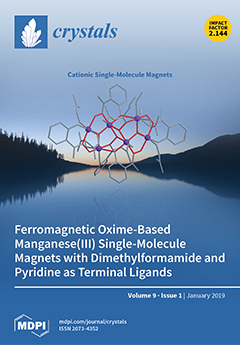Phenanthroline dioxothiadiazoles are redox active molecules that form stable radical anions suitable for the construction of supramolecular magnetic materials. Herein, the preparation, structures and magnetic properties of bis(triphenylphosphine)iminium (PPN) salts of [1,2,5]thiadiazole[3,4-f][1,10]phenanthroline 1,1-dioxide (
L), [1,2,5]thiadiazole[3,4-f][4,7]phenanthroline 1,1-dioxide (
4,7-L), 5-bromo-[1,2,5]thiadiazolo[3,4-f][1,10]phenanthroline 2,2-dioxide
[...] Read more.
Phenanthroline dioxothiadiazoles are redox active molecules that form stable radical anions suitable for the construction of supramolecular magnetic materials. Herein, the preparation, structures and magnetic properties of bis(triphenylphosphine)iminium (PPN) salts of [1,2,5]thiadiazole[3,4-f][1,10]phenanthroline 1,1-dioxide (
L), [1,2,5]thiadiazole[3,4-f][4,7]phenanthroline 1,1-dioxide (
4,7-L), 5-bromo-[1,2,5]thiadiazolo[3,4-f][1,10]phenanthroline 2,2-dioxide (
BrL), and 5,10-dibromo-[1,2,5]thiadiazolo[3,4-f][1,10]phenanthroline 2,2-dioxide (
diBrL) are reported. The preparation of new bromo derivatives of the
L: 5-bromo-[1,2,5]thiadiazolo[3,4-f][1,10]phenanthroline 2,2-dioxide (
BrL) and 5,10-dibromo-[1,2,5]thiadiazolo[3,4-f][1,10]phenanthroline 2,2-dioxide (
diBrL)—suitable starting materials for further derivatization—are described starting from a commercially available and cheap 1,10-phenanthroline. All PPN salts show antiferromagnetic interactions between the pairs of radical anions, which in the case of
PPN(diBrL) are very strong (−116 cm
−1; using
Ĥ = −2
JSS type of exchange coupling Hamiltonian) due to a different crystal packing of the anion radicals as compared to
PPN(L),
PPN(4,7-L), and
PPN(BrL).
Full article





